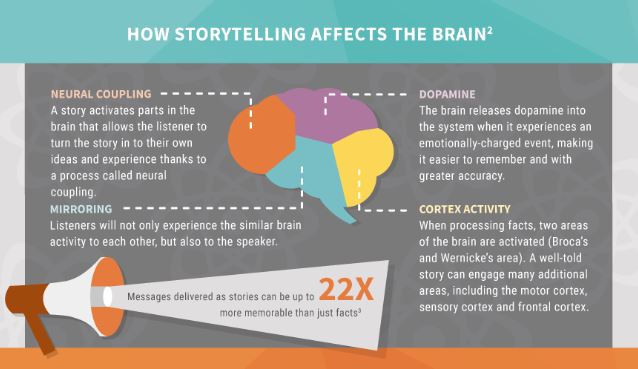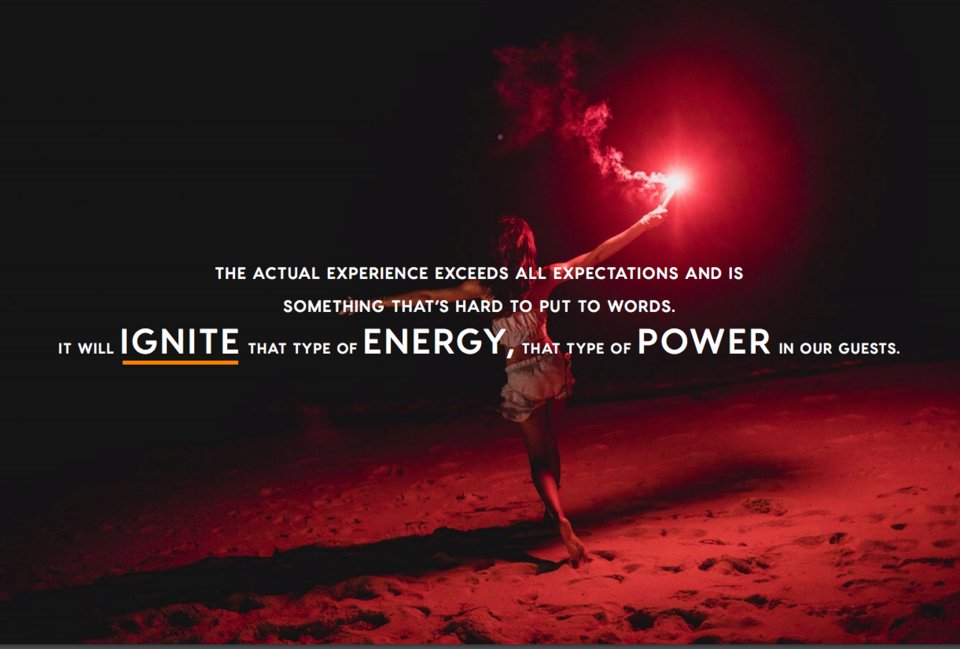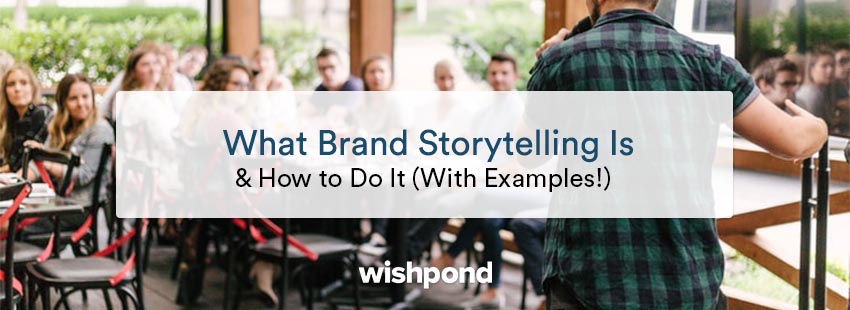Here at Wishpond, we talk a lot about marketing tools — today, we want to talk a bit more about how to put them to best use to make your company shine.
You put a lot of effort into building your company. It may have started as a side job, probably involved a lot of late nights, planning, research, strategizing and unexpected setbacks. (One thing nobody ever said about launching a successful business is, “it was super easy.”)
You may not think this is something you want to advertise, but the truth is, the human struggles behind the logo are sometimes what consumers respond the most to.
You don’t need to live-stream your company meetings, but brand storytelling is one of the most talked-about trends in marketing today, and one of the most important skills.
By the end of this post, you’ll understand why — and what’s more, you should have an idea of how to start putting together your own brand story.
What is brand storytelling?
It helps to know what your brand story is NOT. Your brand story is NOT the facts about your company, your founding date, or a few perfunctory paragraphs on your “About Us” page.
What brand storytelling is using narrative to forge a genuine connection with your audience and consumers. Today – with so many messages thrown at consumers every second, from every direction – knowing how to craft one that resonates with them is an invaluable skill.
As much time as we spend pointing out the logical reasons our service and product is the best (which you should keep doing!), it’s also important to keep in mind that consumers’ emotions are one of the strongest drivers of purchase decisions.
Consumers today want to know that there are people behind the brand. They want to know about their values. They want to feel something about your product, they want to be able to relate, and they want to feel good about buying it.
They’re not just buying your product. They’re buying how it makes them feel.
The Science Of Brand Storytelling
(Note: This is actual science, so skip this part of you want to go straight to the marketing tips, but stick around if you want biological proof it’s worth your time.)
It takes time to develop your brand’s story and learn how to tell it well, and it’s not something you can integrate into every marketing message. Sometimes, your brand story has to be a standalone campaign, designed and executed separately.
This can seem like a lot of effort if you’re new to brand storytelling. That’s why it helps to know the science behind it.
Our brains respond to stories. We are biologically programmed to respond to them. According to the UNHCR, certain types of stories influence our actual brain chemistry, releasing oxytocin (a hormone so associated with social connectedness it is sometimes referred to as ‘the cuddle hormone’)
This OneSpot infographic has more about the statistics behind storytelling.

That’s the power of a brand story.
How to Do It
So now you know what it is and that it pays dividends.
Now for the most important thing: how do you do it?
As with anything in marketing, there’s not a defined set of blueprints: stories are as unlimited and individual as the companies and the people that tell them.
However, here are a few guidelines we can give you to help structure a good brand story.
Focus on Your Values
Example: Warby Parker
Warby Parker here shows the effectiveness of focusing on their values.
Their promotional video doesn’t involve the high tech or high style or high fashion other eyewear brands go for. Instead, it zeroes in on the affordable, fashionable eyewear it’s known for, to great effect.
Warby Parker’s ads and social media have skyrocketed it to one of the most recognizable and successful eyewear brands on the market.
Tips for highlighting your values in brand storytelling:
-
If you’re wondering how to get started, here’s a quick exercise. Have you and three other teammates list your company’s top five core values.
-
Once you agree, brainstorm a list of ways these show up in real, tangible ways in your products or services. This could be in your customer service, in your method of production, in your commitment to quality — there are several ways values can express themselves! This might be the start of a few ways you can tell your brand’s story.
-
If you do any social outreach that ties in with your values, don’t be shy about showing it! Instagram, video, do a match-for-match donation program, partner with relevant charities; corporate social responsibility is becoming increasingly important.
Embrace Your Roots
Example: Burt’s Bees
The humble lip balm embraced its image with this charming and simple ad. They openly reject the idea that their founder started the company with anything as buzzwordy and techy as a strategy or investor capital.
What he did have was a bunch of bees.
This is genius brand storytelling. The ad sticks closely to the brand’s colors and text, aligning it both for loyalists and those only vaguely familiar with it.
If you’re not convinced, the proof is in the earnings report. In 2018, Burt’s Bees was reported to have sold, on average, once every second somewhere in the world.
Address Your Customers’ Pain Points
Example: Aerie

We’ve mentioned Aerie before for their mastery of communication through this campaign. They’ve based a lot of their current brand image on their Aerie Real campaign, which focuses on a diverse set of models.
On that note, notice how the campaign website doesn’t immediately appear to be a clothing store: it almost looks like a lifestyle blog or advice column. And they walk the talk with their range of models.
Tips for addressing your customers’ pain points in brand storytelling:
-
Mine your customer reviews for what customers are saying they love about your product; it might not be what you think! For example, while you might be super proud of your camera’s formidable technical specs, your customers may appreciate that but be more thrilled by its lightweight or incredible battery life. Realizing what’s really causing problems day-to-day for your customers, and adding that to your brand message, is powerful.
-
Address your customers’ pain points in more than one way. For example: provide content and helpful advice, place relevant reviews front-and-center, if you offer a service, maybe host a webinar offering tips and helpful hints.
Understand Your Audience
Example: Trader Joe’s
While it appears simple, this Trader Joe’s ad demonstrates the uniqueness and effectiveness of their marketing strategy.
It effortlessly dodges alienating any of their audience, as it knows it has a wide base of different shoppers, and it emphasizes its unique value and what all these very different people come to Trade Joe’s for: supermarket shopping that’s friendly, off-kilter, fun, convenient, affordable and, at the same time, tasty, exotic and high quality.
Trader Joe’s is known for their marriage of high quality and low prices. Their tone is relaxed and friendly, but adventurous and knowledgeable: like an exceptionally well-traveled friend who knows all the best spots to eat and has tons of exotic recipes to try.
One article notes about their dedication to their brand story in everything from their job titles to their product descriptions.
(One other point about understanding the audience: note the subtle singling out of their wildly popular product, Cookie Butter, at the start of the video. A treat for Cookie Butter loyalists, and an easy way to promote the product to anyone who’s been thinking of trying it. Nicely played, Trader Joe’s.)
Be Authentic
Example (of how NOT to tell your brand story): Fyre Festival

As marketers and business owners, there’s a sort of morbid fascination in dissecting the entire cycle behind the infamous Fyre Festival. Which is not entirely bad, because there’s a lot to learn from the ashes of it.
One of the best ways to understand the importance of valuing authenticity and honesty in your brand story is watching what happens when you don’t.
The foundations now-infamous Fyre Festival was built entirely on the captivating story they told their investors in a pitch deck and ticketholders on Instagram about the kind of experience they could create.
The pitch deck, promotional photoshoot, and video are on-point in messaging, and you can see why — with the right hype team, in the right environment — investors could be excited enough to pour in more than $20 million.
Yet, Business Insider pointed out the myriad exaggerations (and outright fabrications) that Fyre’s brand fable weaved to conjure up their capital. This included:
- Wildly inflated attendee estimations
- Listing big-name partners that were not involved with the venture (including Snapchat).
- Stating they owned land in the Bahamas that they didn’t.
If you don’t know how this ends, the short version is a very public disaster unrolling in real-time on the days of the festival, a media circus, two separate documentaries about the fiasco, and jail time for the founder.
There you have an overview of brand storytelling and a run down on how to think about telling your brand’s story.
What are your favorite examples of brand storytelling? Let us know in the comments!


